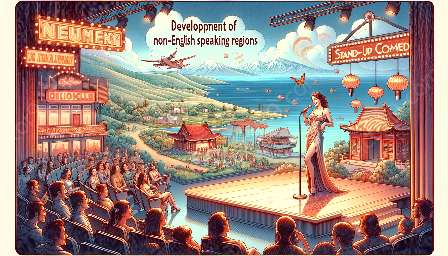Stand-up comedy is a unique form of entertainment that has gained popularity across various cultures around the world. As the art of stand-up comedy transcends linguistic and cultural barriers, the translation of stand-up comedy across different cultures has become a fascinating subject of study. This topic cluster aims to explore the challenges and nuances of translating stand-up comedy, its compatibility with the history of stand-up comedy, and its influence on the global comedy scene.
The History of Stand-Up Comedy
The history of stand-up comedy dates back to ancient times, where comedic performances were a popular form of entertainment in various cultures. However, the modern concept of stand-up comedy as a solo comedic performance delivered directly to an audience emerged in the United States during the late 19th and early 20th centuries. Comedians such as Mark Twain and Vaudeville performers paved the way for the development of stand-up comedy as a distinct art form.
Stand-up comedy went through various phases of evolution, from the comedic monologues of radio and television to the edgy and socially relevant performances of contemporary comedians. The history of stand-up comedy is marked by significant cultural and social influences, reflecting the changing dynamics of society and humor.
Stand-Up Comedy
Stand-up comedy is characterized by its direct interaction between the comedian and the audience, often involving improvisation, storytelling, and observational humor. Comedians rely on their wit, timing, and delivery to engage and entertain the audience. The art of stand-up comedy allows performers to address societal issues, confront taboos, and provide insightful commentary while eliciting laughter from their audience.
Translation of Stand-Up Comedy
Translating stand-up comedy presents a unique set of challenges due to its reliance on language, cultural references, and humor. The nuances of comedic timing, wordplay, and cultural context play a significant role in the successful translation of stand-up comedy across different languages and cultures. Translators must navigate cultural barriers and linguistic nuances to preserve the comedic essence of the original performance while making it relatable and humorous to the target audience.
One of the primary challenges in translating stand-up comedy is maintaining the authenticity and comedic impact of the original material. Cultural references, wordplay, and idiomatic expressions often pose difficulties in conveying humor across different cultures. Translators must have a deep understanding of both the source and target cultures to effectively capture the intended humor of the comedian.
Cultural Adaptation
The process of translating stand-up comedy often involves cultural adaptation, where certain jokes or references may need to be modified to resonate with the audience's cultural background. Additionally, translators may need to provide explanatory footnotes or context to ensure that the audience understands the cultural references embedded in the comedic material. Through cultural adaptation, the essence of the comedy is preserved while catering to the linguistic and cultural nuances of the target audience.
Global Impact
The translation of stand-up comedy has played a significant role in the globalization of comedy, allowing audiences from different cultures to appreciate and enjoy comedic performances from around the world. International comedians have gained recognition on a global scale, transcending language barriers and cultural differences through the translation of their comedic acts. This exchange of comedic content fosters cross-cultural understanding and appreciation for diverse forms of humor.
Influence on the Comedy Scene
The translation of stand-up comedy across cultures has reshaped the global comedy scene by introducing audiences to a rich tapestry of comedic voices and perspectives. It has broadened the horizons of comedy enthusiasts, offering access to a diverse array of comedic styles, themes, and performers. The cross-cultural exchange of comedic content has inspired collaboration and creativity within the comedy community, leading to the emergence of innovative comedic expressions that reflect the multicultural landscape of humor.
Furthermore, the translation of stand-up comedy has paved the way for cross-cultural comedy events, festivals, and collaborations, promoting cultural exchange and understanding through laughter. It has facilitated the appreciation of humor as a universal language that transcends borders, uniting audiences through shared laughter and relatable comedic experiences.
Conclusion
The translation of stand-up comedy across cultures represents a dynamic intersection of language, humor, and cultural exchange. It underscores the universal appeal of comedy while highlighting the intricacies of translating humor across diverse audiences. As stand-up comedy continues to thrive in a global context, the art of translation plays a vital role in connecting comedians and audiences from different cultures, fostering mutual appreciation and laughter that knows no bounds.
























